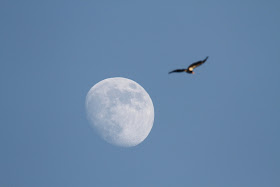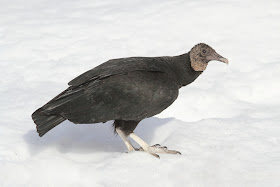If you shoot birds in flight, you’ve probably been frustrated by trying to get the exposure right. Either the bird is blown out, or, more often, the background sky looks perfect, but the bird is just a dark silhouette. Been there, done that, hit the “delete” button. If you expose the bird perfectly (yay!) the sky is probably too light (boo!).
There are a
number of ways to fix such shots. Making major adjustments usually cause some
problems. Noise and artifacts appear whenever you lighten a photo, so starting
with a photo where the sky looks good, but the bird is too dark probably won’t
win you any awards. Let’s work on how to fix the best of the miserable shots
you ended up with – the ones where the bird is exposed the way you want it but
the sky is too light. Since the bird is the main subject, that’s the part of
the picture that you will want to look best anyway.
The simple
way to fix you photo is to make a separate layer, adjust the sky, then mask the
bird. That’s fine if you aren’t going to print the shot or try to sell it, but
it is VERY difficult and time-consuming to get the mask just right. There are
places that you just can’t get right (teeny-tiny feather edges) and such. If
you use the “Select” tool, there are often parts of the birds that aren’t
selected properly, and if you zoom way in, there will be little jagged edges
along the lines where one set of pixels were selected while others weren’t.
Nothing is more disappointing that working forever on a single photo and, when
you are done, it looks so bad that you just delete it.
While
nothing beats getting the perfect shot in the first place, there is a way to
fix these kinds of shots fairly quickly without showing a lot of boo-boos if
you zoom way in or print the photo at a larger size. Yes, you can take a lot of
time to go around and clean these things up, but it is time-consuming, and
doesn’t always leave a great end product.
This technique will leave you with nicer edges
Let me also
take a second to mention that I have to downsize these shots a lot to use on my
blog page – there is WAY more detail in the full-sized shots. I’m also making
the assumption here that you have a basic understanding of how to use layers
and masks. If you DON’T know how to use these, LEARN!!!!! It will improve your
processing a million percent and cut the time it takes by about the same
amount. Photoshop and Corel Paint Shop Pro pretty much work the same way in the
steps I’m going to explain.
Let’s look
at a fairly quick and easy way to fix the shot below that is lacking sky detail:
First step,
run a noise-reduction step – we’re going to darken the photo and that always
adds a little noise. Second, remove the bird (WHAT???) using a large clone tool
and save the file using a different name.
Next, make a
duplicate layer and set the layer type to “Multiply.” Duplicate the multiplied
layer a couple of times until you like the way the sky looks. In this case, I
used three layers. Merge all the layers down. Now the sky looks better, but it seems to be missing a bird.
Next, go
back to your ORIGINAL photo, copy the entire thing and post as a new layer. If
you want to reposition the bird, you can select an area around the bird (instead
of copying the entire photo) making sure to get a little of the background all
around it and place it where you want. Make a duplicate copy of the layer you
just copied in and click the “Visibility” button to make the top layer
invisible. You now have 3 layers. The bottom layer is the adjusted sky without
the bird, the second (middle) layer is the original photo, and the top layer is
the original photo, but not visible. At this point, your photo will appear to
look just like the original photo since it is on top of the adjusted sky photo.
Now, set the middle layer type to “Darken.” This will put back most of your
bird as shown below:
The problem
is that the white/light areas of the bird will appear blue as they are not
darker than the background. The nice thing is that the computer did all the
hard work of putting in all the really fine details on the darker edges of the bird
without leaving any harsh transitions.
Next, make
the top layer visible again and select a mask that masks the entire photo.
Using a white brush, carefully unmask the white/light areas of the bird. You
may want to brush across the entire body of the bird to bring up white/light
areas there as well. The only place you really have to be a little careful is
where the white on the bird reaches the very edge of the body. Still, it is not
very difficult to get nice results without much effort – now you only have to
work on a few areas with the mask because the computer did the rest.
Before and after:
To see more
detail, you can view a large version of the above photo at:
Here’s the finished product:
Is it cheating? I'll let you make your own decision. Either way, this is the way it looked through my viewfinder when I took the photo and now I have a nice photo. Essentially, this isn't much different than just selecting the sky only and darkening it. The real difference is that this method only impacts the sky behind the bird and leaves the bird exactly as it was - which is the whole point of what you otherwise would have been trying to achieve by just selecting and working on the sky. The difference is that this method doesn't leave a bunch of lines or require a ton of work to make it look good.
I will admit that using photoshop too much can be thought of as turning a photo into art. The same can be said about using polarizers and colored filters - techniques used by photographers for decades. The same can be said about techniques old-timers used in the darkroom such as dodging and burning to give mist around moving water or even (gasp) trying to save a photo like the one I started with.
In this case, I didn't add or delete a single element of the photo. I was simply VERY selective about which components I darkened (which is what a "Multiply" layer does). I didn't even change the contrast, color or saturation. If someone said that they simply darkened a photo, most people would just shrug their shoulders and say, "So what?"
Decide for yourself what you want to do. There may be a gray line (or even a black line) between what you consider art and photography, but you can always fix that with Photoshop ;-)
Steve Byland is a wildlife photographer living in suburban New Jersey. His photos can be seen at www.stevebyland.com . You can email him at sbbyland@aol.com
I will admit that using photoshop too much can be thought of as turning a photo into art. The same can be said about using polarizers and colored filters - techniques used by photographers for decades. The same can be said about techniques old-timers used in the darkroom such as dodging and burning to give mist around moving water or even (gasp) trying to save a photo like the one I started with.
In this case, I didn't add or delete a single element of the photo. I was simply VERY selective about which components I darkened (which is what a "Multiply" layer does). I didn't even change the contrast, color or saturation. If someone said that they simply darkened a photo, most people would just shrug their shoulders and say, "So what?"
Decide for yourself what you want to do. There may be a gray line (or even a black line) between what you consider art and photography, but you can always fix that with Photoshop ;-)
Steve Byland is a wildlife photographer living in suburban New Jersey. His photos can be seen at www.stevebyland.com . You can email him at sbbyland@aol.com

a.jpg)
.jpg)




.jpg)






























